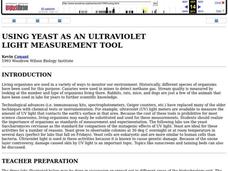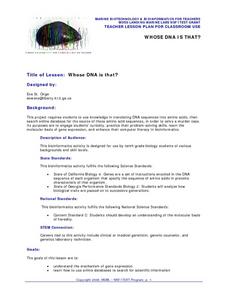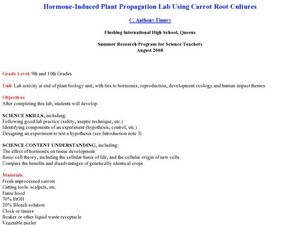Curated OER
"The Collaborative Group Information Collection, Interpretation and Dissemination Technique"
Students answer the question "How are the concepts and processes I examine in Biology relevant to my other classes, to my life, and to my community?" This assignment has students actively involved in the intellectual work of location,...
Curated OER
Investigating the Uses of Backyard Bacteria
Students discover that the answers to some of society's waste and clean-up problems may be no further than the soil beneath their feet. They perform a Gram stain on the colonies to determine some of their characteristics.
Curated OER
Active Ingredient Screening Test for Plants
Students explore the growth of bacteria. They determine if various plant materials contain active ingredients that inhibit the growth of bacteria. In addition, they complete a student data sheet.
Curated OER
Genetic Decision Making Model
Students examine case studies involving bioethics. They write a paragraph explaining the problem. Students construct a list of values that are involved in the conflict. They list probable solutions to the problem and consequences to...
Curated OER
Separating a Starch-Glucose Mixture Using Gel Filtration
Students experiment using the basic principles of gel filtration. They use the gel filtration technique for testing for the presence of specific substances. Students discover that starch is a larger molecule than glucose.
Curated OER
Using Yeast as an Ultraviolet Light Measurement Tool
Students accurately measure the relationship between radiation dose and either survival or some genetic event such as mutation or recombination. They investigate the damage that was done to the DNA molecule as a result of exposure to...
Curated OER
Active Ingredient Screening Test for Plants
Students determine if various plant materials contain active ingredients which will inhibit the growth of bacteria. They identify plant materials and their degree of sensitivity.
Curated OER
ECOLOGICAL BIOASSAY OF COPPER SULFATE IN DAPHNIA MAGNA
Students use this lab as a follow up to the introduction of the ecosystems and productivity levels, bioassays and what and how they measure, and Daphnia magna as an index organism, i.e., a species whose health within an ecosystem...
Curated OER
Bioinformatics
Students are exposed to the tools and databases currently used by researchers in molecular and evolutionary biology. They gain a better understanding of gene analysis, taxonomy, and evolution.
Curated OER
Whose DNA Is That?
Students investigate the use of technology in order to identify different sequences of amino acids by using online web tools. They enhance problem solving skills with amino acid identification skills and strengthening comfort with using...
Curated OER
Model Organisms: The Genes We Share
In this genetics worksheet, students access a website to learn about how human genes mutate to cause heritable disorders such as Huntington disease. Students use the information on this website to complete 12 short answer questions.
Curated OER
DNA in the Garden - Families and Friends: Grouping and Sorting
In this grouping and sorting activity, students learn about sorting objects and living things into larger and smaller groups. They complete an exercise in which they sort cutlery, and then students answer the 3 questions on the page.
Curated OER
Hormone-Induced Plant Propagation Lab using Carrot Root Cultures
Students evaluate the importance of hormones in living things. In this biology lesson plan, students experiment on carrots to differentiate how humans and plants reproduce. They collect data from experiment to answer analysis questions.
Other popular searches
- Agricultural Biotechnology
- Pictures of Biotechnology
- Biotechnology Project
- Food Biotechnology
- Agriculture Biotechnology
- Biotechnology and Farming
- Biotechnology Crops
- Plants Biotechnology
- Biotechnology Careers
- Biotechnology and Business
- Biotechnology Class Notes
- 5 Pictures of Biotechnology














